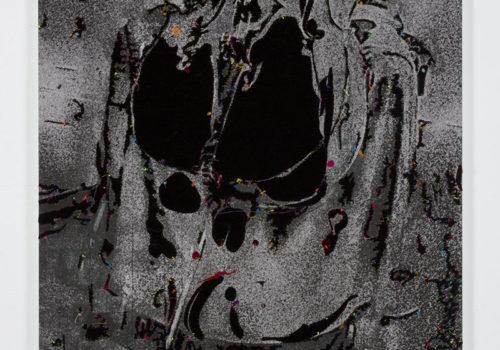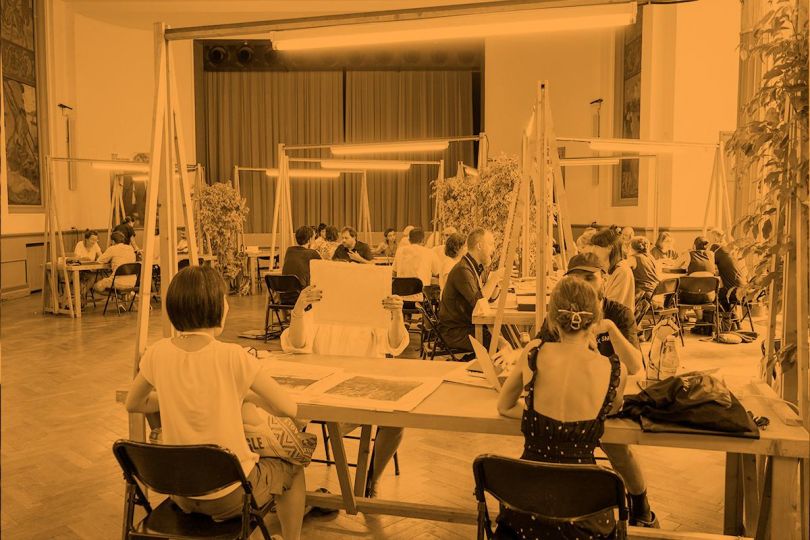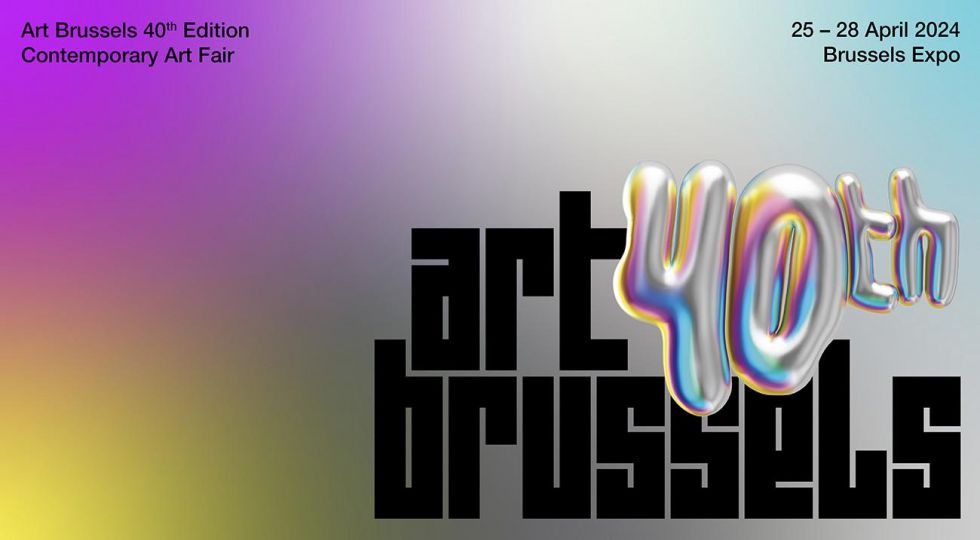Galerie Fons Welters: Berend Strik (The Netherlands, 1960) (images 66-68)
In his work, Berend Strik (1960, Nijmegen) questions the meaning of images. Strik subjects his photographs to an intensive process of reworking with fabric and thread. The sewn photographs slow down our gaze and thus emphasise the image and its content. By partially covering his images, the artist constantly exposes different layers (of meaning).
Strik himself says: “It’s like forcing a photograph by piercing it with pins and needles and sewing it up. A force, so to speak, is applied to the photograph to allow multiple new meanings to emerge. […] The force applied relates to the imaginary of the photograph. The moment that the photograph shows is no longer there, but the applied material brings the photograph back into the here and now. [Photographs make an impression, they are charged with history and various issues. In this way, the edited photograph begins to act as a kind of valve. Through editing, all possible associations and memories seem to fill the image, the image somehow fills itself.
Galerie Fons Welters
Bloemstraat 140
1016 LJ Amsterdam
(+31) 20 423 30 46
www.fonswelters.nl
mail(ad)fonswelters.nl
Galerie Ron Mandos: Jacco Olivier (The Netherlands, 1972) (images 69-71)
This work can be seen as a projection at the Art Rotterdam Fair, but will also be projected on the Euromast, a tall (186m – 606ft) landmark dating from 1960. This is a present of the Ron Mandos Gallery to the city of Rotterdam and the festival week.
Jacco Olivier fuses painting and filmmaking by repeatedly reworking paintings in generous casual brush strokes and systematically photographing each development. The various stages are combined into projected animations. The resulting films are enigmatic and experiential – moving in and out of abstraction they reveal the traces and decisions made by the artist in the process of painting. While there is a clear and quite complex process involved in their creation, Olivier does not set a thematic agenda for the works, or for their relationship to one another. The films are instead imagined as windows onto converging, and often elegantly simple, moments of daily life – a bus journey, a swim in the ocean, or a walk through the woods. At this convergence of painting and cinema, however, lies an uneasy tension, a feeling that something is about to happen or has just happened that is unexpected and beyond our control.
Galerie Ron Mandos
Prinsengracht 282
1016 HJ Amsterdam
+31 20 3207036
mail(ad)sronmandos.nl
Galerie Valeria Cetraro: Anouk Kruithof (The Netherlands 1981) images 72-74
Connecting with non-human forms of life, opening up to the plurality of worlds, broadening the scope of sensitivities, and, by doing so, transforming oneself: science-fiction tales and anthropological investigations both consider these mutations a fundamental stake to envision the future. Although these projections are far from being a commonly shared model yet, we are currently witnessing the revalorisation of alternative knowledge, the powers of plants, the re-appropriation of rituals, and are increasingly hearing the whisper of oral transmissions.
Trans Human Nature is the story of a personal experience and of an artistic exploration which, to me, seem to talk about these contemporary challenges. At the end of 2018, Anouk Kruithof sets off to explore Surinam, an unknown small country of Amazonia, a former Dutch colony, the Netherlands being where the artist is from. During her expedition, she discovers a village in the middle of the forest, Botopasi, only connected to civilisation through the river, and this encounter is decisive. After having lived in the great art capitals – Berlin, New York, Mexico, Brussels –, Anouk Kruithof decides to build her house in Botopasi and will live there a transforming experience over several months, until the covid crisis brings her back to Europe. In this village, she works in symbiosis with nature and people. Settling her practice in this context had an impact on what she was producing there, or rather what was being produced there. Anouk Kruithof stores prints of her digital iconography based images on the pirogues connecting the village, takes the prints with her on forest hikes, immerses them in the river, hides them in the greenery, handles them whilst observing their capacity to become one with a wild, powerful and sometimes also violent nature. The images she produces then come to relate a self-transformation process through the contact with a dense and tropical nature.
Anouk Kruithof is a Dutch artist born in 1981 who settled in Mexico City and New York from 2011 to 2015. Today, she lives and works between Belgium (Brussels), The Netherlands, and her wooden house in the middle of the Amazon rainforest in Botopasi (Surinam).
Galerie Valeria Cetraro
16 rue Caffarelli.
75003 Paris
+33 (0)9 82 61 61 11
info(ad)galerievaleriacetraro.com
KANT Gallery – Copenhagen – Susanne Wellm (Denmark 1968) images 75-77
Susanne Wellm works with photography as her primary medium. Since the 1990s she has explored a wide array of photographic techniques, both analogue and digital, often artistically utilized in a merged form. Exploring the physical qualities of the two-dimensional image she developed a method combining photography and weaving, adding complex, tactile layers of colour, contrast and depth to the expression of the pieces.
An omnipresent vein running through Wellm’s practice is her interest in time, memory and the construction of narrative. With a starting point of a vast archive of found imagery from old family albums, historical movie stills and original screenshots, Wellm draws connecting lines between the personal dramas of everyday life and the collective history and trauma of modern Europe. Through the use of collage and montage, she pieces together well-known, and often humble, sections of reality, into multi-layered, poetic pictorial spaces, wherein fiction and fact, stagnation and movement, the internal and the external melts together into acutely meaningful moments, cinematically mapping out an action, but all the while remaining open to interpretation.
Hinting and unfinished, Wellm’s pieces instigate a reflection on our eternal search for meaning, within the tangled relations between ourselves and the world, between past and present. Susanne Wellm is a 1995 graduate of The Royal Danish Academy of Architecture, Design and Conservation, and has since exhibited widely, nationally and internationally.
KANT – COPENHAGEN
St. Kongensgade 3
1264 Copenhagen K
Denmark
+45 29 46 63 31
info(ad)gallerikant.dk
Martin van Zomeren GMvZ – Vytautas Kumza Lithuania 1992 (images 78-81)
Sometimes you see new artworks and you know this is really a new step. This certainly applies to Vytautas Kumza. He is a photographer, but also describes his work as artworks. He adds elements, dada-like to the work, exploring the relationship between the two-dimensional work and reality.
My work exists in a universe governed by a deceptive and fantastical logic that elevates the banality of everyday life into a status of oddity. The content of the work holds an obsessive look for meaning, staging conversations with objects that remain mute, anticipating a space where all things activate each other as to orchestrate a performance between the animated and the lifeless. In this photograph spatial constellation is constructed from a flat imagery of a foot. As an attempt to expand visual depth was used repetition of the same cut out fragments of a print creating unusual glitch for the viewers eye.
Vytautas Kumza is Lithuanian-born, Amsterdam-based artist. In 2017 he graduated from Gerrit Rietveld Academy in Amsterdam. He has held several solo shows in Lithuania and Netherlands, participated in group shows in Lithuania, Netherlands, Germany, Italy, France, Greece, Czech Republic.
Martin van Zomeren
Hazenstraat 20,
1016 SP Amsterdam
+31 20 420 8129
contact(ad)gmvz.com
Plus One & Sofie Van de Velde: Max Pinckers (Belgium 1988) images 82-84
Max Pinckers grew up in Indonesia, India, Australia and Singapore, and is currently based in Brussels, Belgium. His work explores the critical, technological, and ideological structures that surround the production and use of documentary images.
Documentary photography, for Pinckers, involves more than the representation of an external reality: it’s a speculative process that approaches reality and truth as plural, malleable notions open to articulation in different ways. Like the external world that it claims to represent, the documentary image is inherently unstable, dependent on context and on customary languages of realism. Pinckers’ work draws on contemporary and historical debates, merging fact, fiction and imagination to reflect on the ways the real is defined and represented. It treats documentary as a hybrid practice involving not just images, but objects, performance, texts, found footage and sculptural interventions that investigate the complex nature of perception. Collaboration is essential to Pinckers’ practice, creating a space for the exchange of ideas between himself and the people he works with, and for critical examination of his own position as a photographer.
Ultimately, Pinckers’ self-reflexive work sets out to question both documentary discourse and artistic practice—to create new modes of documentary that foreground the deceptive nature of images yet always emotionally and empathically engages with people and their stories.
PLUS-ONE Gallery (New South) & Gallery Sofie Van de Velde
Léon Stynenstraat 21
2000 Antwerpen, Belgium
&
Vlaamse Kaai 74-75
2000 Antwerp, Belgium
info(ad)plus-one.be
SCHWARZ CONTEMPORARY: JENNA WESTRA (US 1986) images 85-87
JENNA WESTRA is a New York based artist working with photography and film. Her work focuses on images of the female body, creating a safe visual space that transforms seemingly accidental or chance movements into intentional, choreographed actions for the camera. Taking aesthetic cues from performance documentation and postmodern dance, she invites the viewer to re-examine their role in the dynamics of image production and consumption. Her work is widely exhibited.
SCHWARZ CONTEMPORARY
Sanderstraße 28
12047 Berlin
+49 – 30 – 612 89 902
mail(ad)schwarz-contemporary.com
Spazio Nuovo: Giuseppe Lo Schiavo & Marco Maria Zanin
Giuseppe Lo Schiavo (Italy, 1986) (images 88-90)
“Giuseppe Lo Schiavo presents a new production of works focusing on the new technologies and on artificial intelligence that allow us to explore reality by imitating it or by creating new knowable realities. In recent times we are witnessing a hybridization between reality and virtuality that does not devaluate the physical world, instead it opens it to new perspectives: art transforms reality, overturns it and offers it to us as an instrument of critical reinvention of modern times.
For the artist reality is not a still concept, but rather a fluid and above all, a fragile phenomenon that manifests itself as a subjective experience conditioned not only by a cultural but also by a biological component. His works seek to redefine the idea of reality searching for a possible path through the use of three-dimensional images and spaces presented with a high level of photorealism tending to baffle and confuse the identity of the works themselves.
The physical world enters the virtual and emerges again in a mutualistic relationship”.
Marco Maria Zanin (Italy, 1983)(images 91-93)
“The body of work that Marco Maria Zanin is presenting – in his double role of artist and anthropological researcher – aims to overcome the asymmetries inherited by euro-centric perspectives and yet present in the everyday speech, by building new relations among objects belonging to different cultures. Diverse artefacts, but united by a structural relationship with the cultivation of the soil and its logic, rhythm and rituals. For the artist, the imagination borne by these objects becomes a means of developing a biography of things that weaves memories and knowledge through a game of free, informed associations respectful of the complexity of the present debate on the re-thinking of the role of museums in managing the ethnographic heritage that is the result of European colonial history.
Soil Kinships presents a new production developed through this last pandemic year and focused on the construction of unexpected connections between the actual subjects of the artist’s research that go from the tools of the rural life in the Veneto region of his origin to the artefacts belonging to the communities he encountered during his anthropological research in South America and Portugal.
The objects analyzed by Zanin are treated as activators of social and human relations. These new juxtapositions and combinations result from intercultural processes and are thus no longer manufactured goods but rather new bodies, heirs of their original environment and now in a dialogue among themselves”
Spazio Nuovo
00186, Roma – Italia
Via d’Ascanio, 20
+39 06 89572855
info(ad)spazionuovo.net
The Ravestijn Gallery: Mariken Wessels (The Netherlands 1963) images 94-96
In Mariken Wessels’ new series of sculptures of Mama and collage works The Sculptor, it is the female body that becomes matter. Positioning herself at the end of a long line of male artists who have produced highly sexualised female fertility idols, Wessels’ own interpretation of the female body abstracts it, liberating it from its status as muse of a male imagination. In her hands, body parts repeat, stack and morph to form monumental bronze and ceramic sculptures that exist beyond the erotic, drawing into focus instead the artist’s long term interest in corporality. In The Sculptor, the female bodies in these 1970s porn images have been cut out and partly replaced by chunks of clay, in which fingerprints are left visible, leaving the male ‘artist’ alone in his arduous efforts of creation.
Prior to her visual practice, Wessels studied acting at the Amsterdam Theatre School, and after a decade-long acting career she went on to study visual arts at the Gerrit Rietveld Academy. Wessels’ work has been widely exhibited and has held solo exhibitions at the Fotomuseum Antwerp (2016) and Fotomuseum Den Haag (2017). Wessels has published numerous books, most notably with Taking Off. Henry my Neighbor, published in 2015 with Art Paper Editions to international acclaim. The book was awarded an honorary appreciation at the Leipzig Book Fair (Best Book Design from all over the World, 2016), won the Author Book Award at Les Rencontres d’Arles (2016) and was included in the selection for Best Book Designs from the Netherlands and Flanders (2015). Wessels’ latest book, Miss Cox (Nude – Arising from the Ground), was published by Fw:Books in 2020.
The Ravestijn Gallery
Westerdok 824
1013 BV Amsterdam
The Netherlands
+31 (0)20-5306005
info(ad)theravestijngallery.com
www.theravestijngallery.com
John Devos
johndevos.photo(ad)gmail.com
















